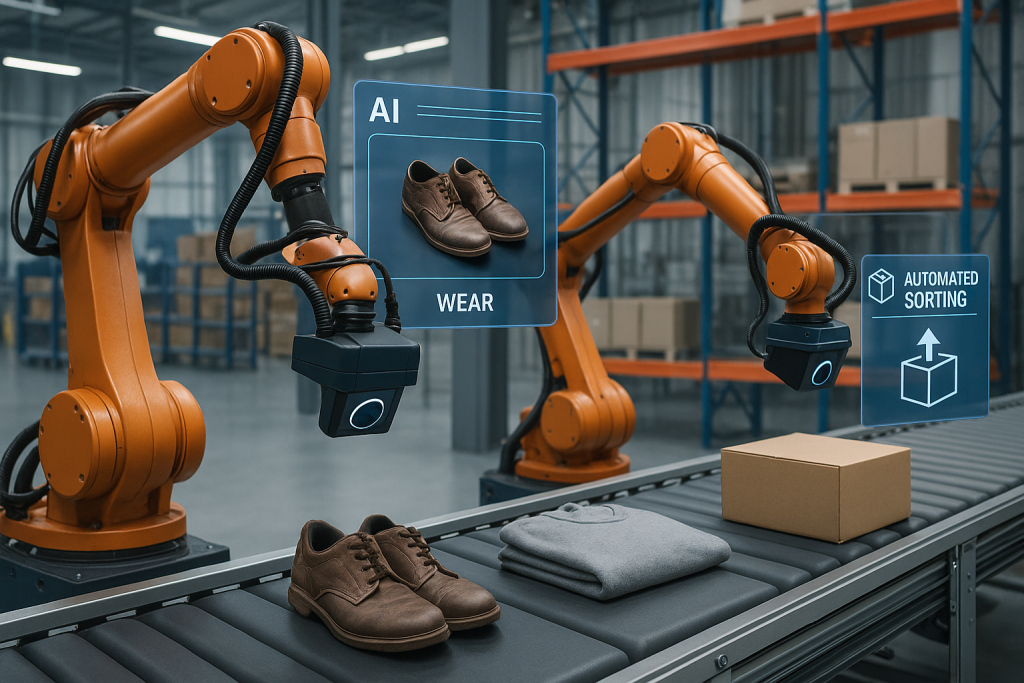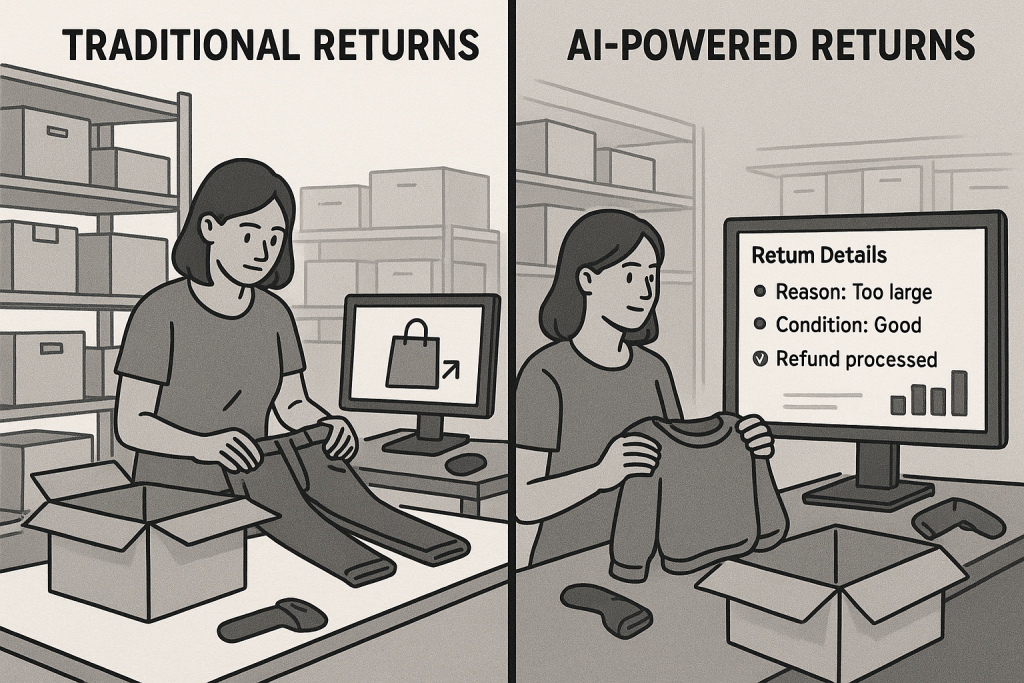Transform Your Return Process with AI-Powered Automation
E-commerce growth has revolutionized retail, but it’s created a significant challenge: managing the ever-increasing volume of product returns. For online retailers, returns aren’t just an operational headache—they’re a substantial financial burden that can significantly impact profitability. The good news? Artificial intelligence is transforming how businesses handle returns, creating opportunities to slash costs while actually improving the customer experience.
In this comprehensive guide, we’ll explore how AI-powered return automation can revolutionize your business operations, reduce processing costs by up to 65%, and turn a traditional pain point into a competitive advantage.

The Current State of E-commerce Returns
Before diving into solutions, let’s understand the scope of the challenge facing online retailers today.
The Growing Returns Problem
The statistics around e-commerce returns are staggering. According to recent industry data:
- 20-30% of all online purchases are returned, compared to just 8-10% for brick-and-mortar stores
- The annual cost of returns in the US alone exceeds $761 billion
- Fashion retailers face even higher return rates, often exceeding 40% during peak seasons
This rising tide of returns creates a perfect storm of financial pressure. Each return generates direct costs for shipping, processing, and potential inventory depreciation. The hidden costs can be even more significant—tying up working capital, creating inventory management complications, and requiring substantial labor resources.
Meanwhile, customer expectations continue to rise. Today’s shoppers expect hassle-free returns with rapid refunds as a standard part of the shopping experience. Using AI-powered templates for return policies can help set clear expectations while maintaining customer satisfaction.
Limitations of Manual Return Processing
Traditional return processes typically follow a labor-intensive path:
- Customer initiates return request (often via phone or email)
- Staff manually reviews and approves the request
- Return shipping is arranged
- Item is received at warehouse
- Product condition is assessed by team members
- Refund is processed manually
- Item is restocked, liquidated, or disposed of
This approach creates several critical problems:
| Problem | Impact |
|---|---|
| Processing delays | Extended refund timeframes leading to customer frustration |
| Inconsistent assessments | Varying decisions on product condition and refund eligibility |
| High labor costs | Significant staffing requirements for relatively low-value work |
| Limited data capture | Missed opportunities to understand return patterns and root causes |
| Fraud vulnerability | Difficulty identifying suspicious return patterns |
As return volumes grow, these inefficiencies become increasingly unsustainable, creating a critical need for technological intervention.
How AI Transforms the Return Process
Artificial intelligence offers powerful solutions to the returns challenge through several complementary technologies working in concert.
Machine Learning for Return Prediction and Prevention
The most valuable return is the one that never happens. Machine learning models can analyze historical purchase and return data to identify patterns and predict which transactions have a high likelihood of resulting in returns.
These predictive capabilities enable:
- Proactive interventions – Targeting high-risk purchases with detailed product information or size guides
- Personalized recommendations – Suggesting products with lower return rates based on individual customer history
- Inventory optimization – Identifying and potentially removing products with consistently high return rates
By addressing return likelihood before purchase, retailers can significantly reduce overall return volumes while improving customer satisfaction through better product matches.
Computer Vision for Return Inspection
When returns do occur, computer vision technology dramatically streamlines the assessment process. Advanced AI systems can now:
- Automatically photograph returned items from multiple angles
- Detect damage, wear, or missing components with high accuracy
- Compare the returned item against original product specifications
- Determine appropriate disposition (restock, discount, recycle)
This technology not only increases processing speed but also improves consistency in assessment decisions—eliminating the variability that occurs with human inspectors and ensuring fair treatment for all customers.

Natural Language Processing for Return Communications
Understanding why products are returned provides invaluable business intelligence. Natural language processing (NLP) can analyze customer return reasons to:
- Identify patterns in product issues or customer dissatisfaction
- Categorize returns into actionable segments
- Generate automated, personalized customer communications
- Analyze sentiment to identify opportunities for process improvement
These insights help address root causes of returns rather than just managing symptoms, creating a continuous improvement cycle that gradually reduces return rates over time.
Building Smart Refund Workflows
Implementing AI-powered return automation isn’t an all-or-nothing proposition. Smart businesses approach this transformation through targeted workflows that deliver immediate value while building toward comprehensive automation.
Return Request Automation
The return process begins with the request, and this is often where the first friction points appear. AI streamlines this critical touchpoint through:
- Digital return initiation – Self-service portals or chatbots that guide customers through the return process
- Smart categorization – Automatic classification of return reasons for appropriate handling
- Rule-based approval – Instant authorization for returns that meet predefined criteria
This automation creates immediate benefits: customers experience a frictionless process while businesses reduce administrative overhead. Creating custom AI automations with Gibion AI can help you implement these smart workflows without extensive development resources.
Intelligent Routing and Processing
Once a return is approved, AI systems can determine the optimal handling path based on numerous factors:
| Factor | Routing Decision |
|---|---|
| Product category | Specialized handling requirements |
| Return reason | Quality control review vs. simple restocking |
| Customer profile | VIP handling for high-value customers |
| Return history | Additional verification for suspicious patterns |
| Product value | Cost-effective disposition (restock vs. liquidate) |
This intelligent routing ensures each return receives appropriate handling while minimizing processing costs and maximizing recovery value.
Proactive Refund Management
The refund process represents a critical moment of truth in customer experience. AI enables several advanced capabilities:
- Instant refund options – Pre-approval for trusted customers before physical return
- Dynamic refund methods – Offering store credit with bonus value versus cash refunds
- Fraud detection – Identifying suspicious patterns while facilitating legitimate returns
These capabilities transform refunds from a purely transactional process into a strategic opportunity to reinforce customer relationships and encourage future purchases.
Measuring ROI from AI Return Automation
Implementing AI return automation represents a significant investment. Measuring its impact requires a thoughtful approach to metrics across multiple dimensions.
Financial Performance Indicators
The most direct benefits appear in operational cost reduction:
- Processing cost per return – Typically reduced by 30-65% with automation
- Recovery value percentage – Improved through faster processing and better disposition decisions
- Labor efficiency – Measured by returns processed per employee hour
- Warehouse space utilization – Reduced backlog through faster processing
Many businesses find that these direct savings alone justify the investment in automation technology, with payback periods often under 12 months.
Customer Experience Metrics
Beyond operational savings, return automation significantly impacts customer satisfaction:
- Net Promoter Score (NPS) for the return process
- Return-to-repurchase rate – Percentage of customers who buy again after a return
- Time to refund – Total duration from return request to money back in customer accounts
- First-contact resolution rate – Returns resolved without additional customer effort
These metrics often show dramatic improvement with AI automation, as consistent processes and faster resolutions directly address key customer pain points.
Operational Efficiency Measurement
Process improvements provide additional value through increased operational capacity:
- Average processing time – Often reduced from days to hours or minutes
- Exception handling rates – Percentage of returns requiring manual intervention
- Return disposition accuracy – Correctly determining optimal handling path
- Peak capacity handling – Ability to manage seasonal spikes without service degradation
These operational improvements create significant secondary benefits, including better inventory management, reduced seasonal staffing needs, and improved scalability.
Implementation Strategies and Best Practices
Successfully implementing AI return automation requires thoughtful planning and execution. Here are key strategies to maximize your chances of success.
Selecting the Right Return Automation Platform
Not all automation solutions are created equal. When evaluating platforms, consider these critical factors:
- Integration capabilities – Seamless connections to your existing e-commerce, inventory, and financial systems
- Customization options – Ability to tailor workflows to your specific business needs
- Analytics capabilities – Robust reporting and insight generation
- Scalability – Capacity to grow with your business and handle peak volumes
- Mobile functionality – Support for both customer and staff mobile interfaces
The ideal platform balances sophisticated capabilities with ease of implementation and ongoing management.
Phased Implementation Approach
Rather than attempting a complete system overhaul, most successful implementations follow a phased approach:
- Process analysis – Document current workflows and identify high-impact improvement opportunities
- Pilot implementation – Start with a single high-value workflow or product category
- Validation and refinement – Measure results and adjust before expanding
- Staged rollout – Gradually extend to additional workflows and categories
- Continuous optimization – Establish ongoing monitoring and improvement processes
This incremental approach reduces risk while allowing your team to develop expertise with the new systems gradually.
Change Management for Return Teams
Technology implementation is only part of the equation. Successful automation also requires thoughtful people management:
- Early involvement – Engage returns staff in the selection and implementation process
- Skills development – Train team members for evolving roles as automation increases
- Clear communication – Help staff understand how automation supports rather than threatens their positions
- Recognition systems – Acknowledge and reward contributions to automation success
With proper change management, returns teams can transition from repetitive processing tasks to higher-value roles focused on exception handling, process improvement, and customer experience enhancement.
Conclusion: The Future of Returns Is Intelligent
AI-powered return automation represents a transformative opportunity for e-commerce businesses. By implementing intelligent workflows, companies can dramatically reduce processing costs while simultaneously improving customer satisfaction—turning a traditional cost center into a competitive advantage.
The most successful organizations will approach this transformation strategically, focusing on high-impact workflows, measuring results comprehensively, and managing the human elements of change with care.
As consumer expectations continue to rise and return volumes grow, the gap between automated and manual returns operations will only widen. For forward-thinking retailers, the question isn’t whether to implement AI return automation—it’s how quickly they can do so while maximizing both operational benefits and customer experience improvements.
Ready to transform your return process? The technology is mature, the benefits are clear, and the competitive advantage is waiting for those who act decisively.
